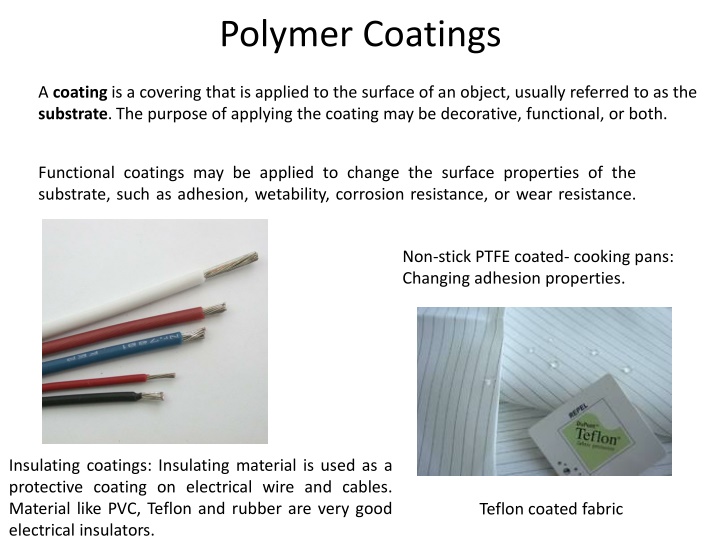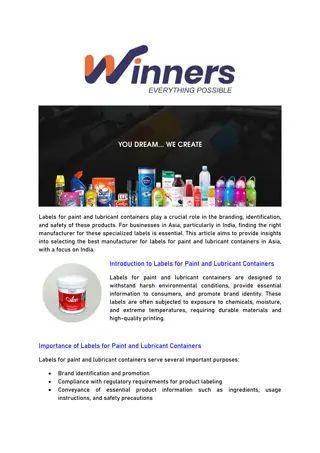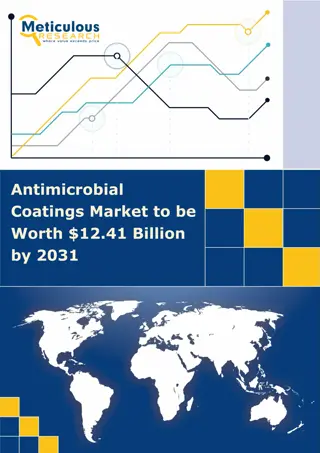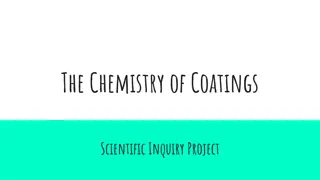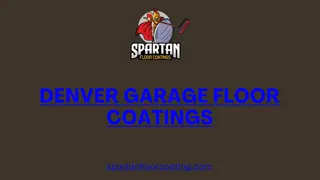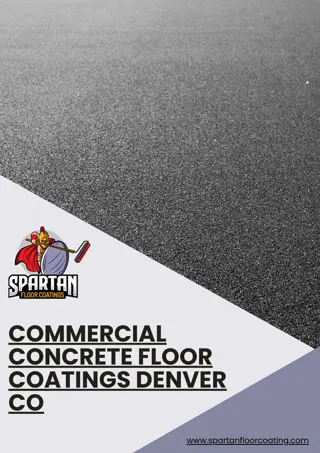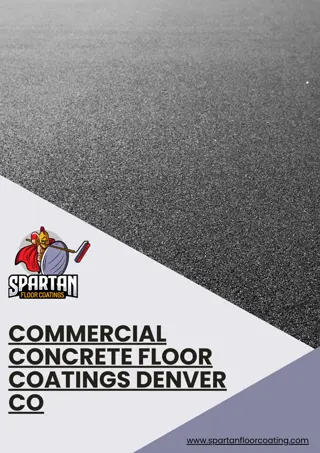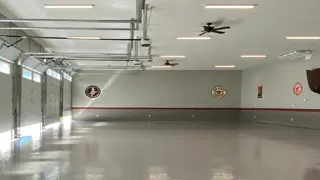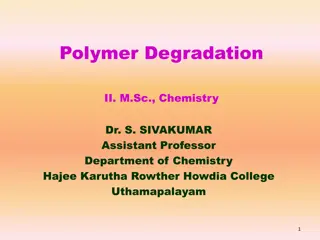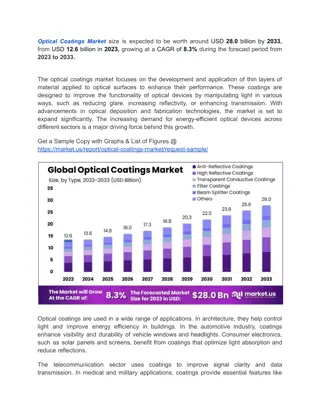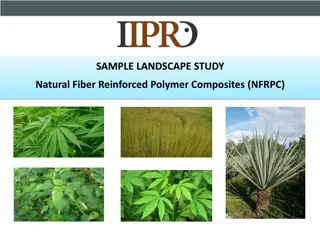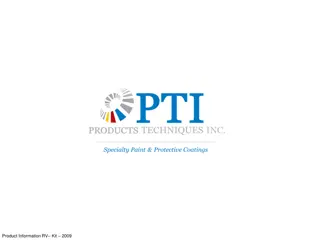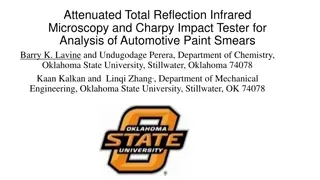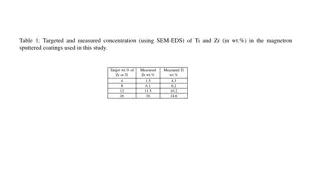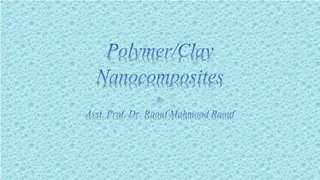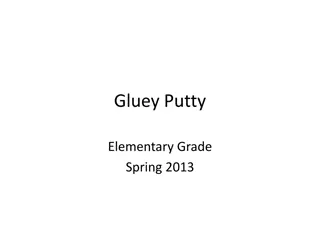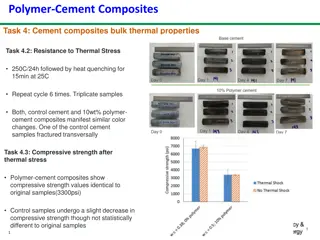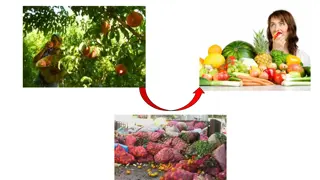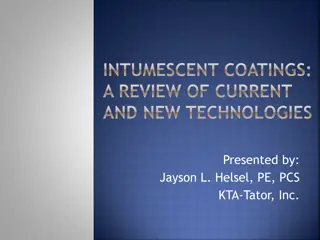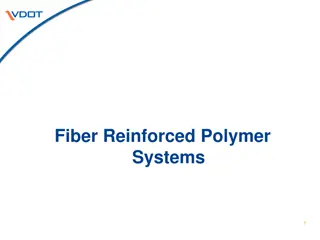Polymer Coatings and Paint Composition
Polymer coatings serve both decorative and functional purposes by changing surface properties like adhesion and resistance. The composition of paints involves solvents, pigments, additives, and resins to protect and beautify substrates. Different pigments like Titanium Dioxide and Zinc Oxide are used for their properties, while resins like Latex, Alkyd, Epoxy, and Polyurethane provide adhesion, durability, and resistance. Alkyd and Latex resin technologies offer benefits for various applications in the coating industry.
Download Presentation

Please find below an Image/Link to download the presentation.
The content on the website is provided AS IS for your information and personal use only. It may not be sold, licensed, or shared on other websites without obtaining consent from the author.If you encounter any issues during the download, it is possible that the publisher has removed the file from their server.
You are allowed to download the files provided on this website for personal or commercial use, subject to the condition that they are used lawfully. All files are the property of their respective owners.
The content on the website is provided AS IS for your information and personal use only. It may not be sold, licensed, or shared on other websites without obtaining consent from the author.
E N D
Presentation Transcript
Polymer Coatings A coating is a covering that is applied to the surface of an object, usually referred to as the substrate. The purpose of applying the coating may be decorative, functional, or both. Functional coatings may be applied to change the surface properties of the substrate, such as adhesion, wetability, corrosion resistance, or wear resistance. teflon coated cable Non-stick PTFE coated- cooking pans: Changing adhesion properties. Insulating coatings: Insulating material is used as a protective coating on electrical wire and cables. Material like PVC, Teflon and rubber are very good electrical insulators. Teflon coated fabric
Basic Composition of Paint Paints and lacquers: Coatings have dual uses of protecting the substrate and being decorative. (The paint on large industrial pipes is presumably only for the function of preventing corrosion). Solvents (Liquids) Pigments Additives Resins (Binder) REF: Comex group ppt: PAINT BASICS AND CORROSION IN METAL AIA103 2
Prime Pigments Titanium Dioxide (TiO2) most widely used white pigment because of its brightness and very high refractive index Zinc Oxide controls mildew (k f) resists ultra-violet light resists yellowing Titanium dioxide is the world's primary pigment for providing whiteness, brightness and opacity. 3
Resins Types: Latex, Alkyd, Epoxy, Polyurethane Binds or glues ingredients (pigments and additives) of paint together Resin provides adhesion to the substrate Resin provides durability & resistance properties: UV-resistance Moisture resistance Chemical resistance Stain resistance Fade resistance REF: Comex group ppt: PAINT BASICS AND CORROSION IN METAL AIA103 4
Alkyd Resin Technology ALKYD (Oil-Based) A synthetic resin made by reacting alcohols and fatty acids Benefits of alkyds: -Abrasion resistance -Good adhesion -Used in rust preventative paint http://ars.els-cdn.com/content/image/1-s2.0-S0300944011002529-gr2.jpg Alkyd resin REF: Comex group ppt: PAINT BASICS AND CORROSION IN METAL AIA103 5
Latex Resin Technology LATEX (water-based) QUALITY Latex paint benefits include: Synthetic polymers Main resins: - 100% Acrylic - Styrene Acrylic - Vinyl-Acrylic - Acrylic Copolymer - Ethylene Vinyl Acetate Color retention Excellent adhesion Scrub resistance Low odor Acrylic acid Chemical structure of the vinyl functional group Ethylene-vinyl acetate REF: Comex group ppt: PAINT BASICS AND CORROSION IN METAL AIA103 6 MMA
Acrylic vs. Alkyd Paints The paint on the left half of each board is acrylic, the paint on the right half, an alkyd. The colors of the paints were identical when applied. After 15 years of weathering, the appearance of the alkyds has changed dramatically. All have lost gloss, faded, and chalked. The acrylic paints, in contrast, have proven remarkably durable with good color retention. REF: Comex group ppt: PAINT BASICS AND CORROSION IN METAL AIA103 7
Coating Methods Pieces Coating Methods Painting Spraying Dipping Film or sheet Coating Methods Rolling Calendering Transfer Coating Extrusion
Painting http://yourmortgagemattersca.files.wordpress.com/2012/05/brush-colour.jpg?w=109h=150 Painting is the practice of applying paint to a surface. The medium is commonly applied to the base with a brush. This is the simlest coating technique. Spraying This process occurs when paint is applied to an object through the use of an air-pressurized (compressed gas)spray gun. The air gun has a nozzle, paint basin, and air compressor. When the trigger is pressed the paint mixes with the compressed air stream and is released in a fine spray. Air gun spraying uses equipment that is generally larger and used for covering large surfaces with an even coating of liquid.
rn : Pskrtme Poliretan (Poli retan Sert K p k) Marka : zoroof K sa Tan m : Yerinde zel makineler ile p sk rt lerek uygulanan sistemlerdir. Ek yeri olmayan tek par a bir izolasyon elde edilir. Is ve ses izolasyonu amac ile uygulanmaktad r. Uygulama Alanlar : Fabrika at lar (eski-y pranm ), in aatlar, konutlar, tavuk iftlikleri, mantar iftlikleri, bal k tekneleri, so uk hava depolar , her t rl at ve zemin yal t m, perde beton yal t m . Teknik zellikler : Is ge irgenlik direnci: 24,6 mW/mK (SI unit=watt/meter.Kelvin) Basma direnci: 175 kPa Kapal h cre miktar : %15 Alev Dayan m : B2 (normal alev al r)-B3 (kolay alev al r) B k lme Direnci: 0,35 N/mm
Electrostatic Spraying The most common method used in powder coating: High voltage (40-100 kV) concentrated at the nozzle of the spray gun causes ionizing of the air passing through the spray gun. Passage of the powder through this ionized air allows free ions to adhere some of the powder particles while applying a negative charge to them. These particles have a strong attraction to the grounded part and deposit there. This process can apply coatings between 20 m-245 m in thickness. Non-charged powder particles do not adhere to the object and will be recycled. Virtually all resins with the exception of nylon can be applied easily with this process. http://www.chinapowdercoating.com/conventional-electrostatic-charging
Electrostatic Painting, Powder Deposition: In these deposition processes, a powder (or sometimes a liquid) is atomized and given an electric charge. The charged particles of powder drift toward a conductive workpiece (the item that is being powder painted), usually with additional airflow assist from a fan or pump. The powder is electrostatically attracted to the workpiece and sticks to it. Then the workpiece is heated, which melts the powder so that it forms a smooth, solid coat. Heat (or UV for a low-temperature piece) will also polymerize the melted powder if the coating is permanently-hardening (a thermoset). The applied voltage is usually negative, but it is positive for nylon and some other materials, because each material has its own charging preference. An insulator can also be electrostatically sprayed if it is very thin and is backed by a grounded conductor.
ELEKTROSTATK TOZ BOYAMA NEDR ? Solvent i ermeyen bir y zey kaplama metodudur. Kaplay c malzeme, son kat boya tabakas n olusturan ok ince toz boya partik lleridir. Toz boya, boya kabininde zel boya tabancalari vas tas yla at l r. Tabancadan elektrostatik y klenen toz boya partik lleri kabin i inde boyanacak malzemeye yap r ve kaplama i lemiger ekle mi olur. Toz boyan n malzeme y zeyine tam olarak malzemenin de ok iyi bir ekilde topraklanmasi gerekir. Fazla atilan boya, kabinde bulunan boya geri kazanim sistemi sayesinde toplan r ve tekrar kullan ma sokulur. Boya geri kazanim sistemi elektrostatik toz boyama teknolojisinin en b y k ekonomik avantajlarindan biridir. Malzeme toz boya ile kaplandiktan sonra pisirme f r n na girer. 200 C olan f rn s s toz boyanin erimesini ve malzeme zerine yap mas n sa lar. Sonu ta ok dayan kl , ekonomik, evre dostu, geni renk yelpazeli ve parlak bir y zey kaplamasi elde edilir. ge erken yap abilmesi i in Solvent i ermemesi, y zey kalitesi, dayan kl l , boya geri kazanim sistemi, ekonomikligi ve evre duyarliligi elektrostatik toz boyamayi geleneksel boyama i lemlerine g re daha ekici bir alternatif yapmaktadir.
Toz boya ile boyanacak olan malzemelere uygulanan ilemler; 1) Malzemeler ilk nce y kama-ya alma ve durulama-fosfatlama b l m nde i lem g r r. Fosfatlama i lemi sayesinde metal y zey zerinde koruyucu bir tabaka olu turulur.Bu sayede metalin hava almas engellenir ve toz boyan n malzemeyi sarmas kolayla r. B ylece metal zerinde olu acak korozyon ve paslanman n n ne ge ilir, malzemenin uzun m rl ve dayan kl olmas sa lan r. 2) Daha sonra malzemelerin y zey temizli i kontrol edilir. E er ki malzemelerde apak varsa temizlenir d zeltme ve z mpara i lemleri yap l r. 3) Malzemeler boyanmak zere konvey r hatt na as l r ve hava tabancalar ile malzemelere hava tutulur. Malzemelerin zerinde toz ve benzeri kal nt lar n kalmad ndan emin olunur. 4) Konvey r hatt ilerlemeye ba lar ve malzemeler toz boya kabininin i ine girer, tabanca sistemleri ile malzemeler toz boya ile boyan rlar. 5) lerleyen konvey r hatt zerindeki malzemeler f r ndan i eriye girmeye ba larlar, malzeme kal nl klar na g re ve boya k rlenme derecelerine g re f r nda zel s ve zaman ayarlar yap l r.Bu sayade malzemenin k rlenmesi(pi mesi) sa lan r. (Boya k rlenme dereceleri 180-210 C aras ndad r) 6) Elektrostatik toz boya ile boyanan malzemeler f r ndan d ar ya kar ve k sa bir s re so umaya b rak l r. 7) B ylece dayan kl , sa lam ve estetik a dan m kemmel bir boya elde edilmi olur. Ref: Karyatek Boya
DIP COATING In a dip-coating process, a substrate is dipped into a liquid coating solution and then is withdrawn from the solution at a controlled speed. Coating thickness generally increases with faster withdrawal speed. The thickness is determined by the balance of forces at the stagnation point on the liquid surface. A faster withdrawal speed pulls more fluid up onto the surface of the substrate before it has time to flow back down into the solution. The thickness is primarily affected by fluid viscosity, fluid density, and surface tension. Dip-coating, while excellent for producing high-quality, uniform coatings, requires precise control and a clean environment. The applied coating may remain wet for several minutes until the solvent evaporates. This process can be accelerated by heated drying. In addition, the coating may be cured by a variety of means including conventional thermal, UV, or IR techniques depending on the coating solution formulation. Once a layer is cured, another layer may be applied on top of it with another dip-coating / curing process.
DipCoating Thickness of layer depends on some parameters like viscosity and solid content of liquid and is formulated: In which: h: thickness : density g: gravity constant : viscosity lv: liquid vapor surface tension v: dtagging speed
neoprene polyurethane Plastisol is the most common dip molding material. It is a mixture of suspended plastic particles (usually PVC) dispersed in a plasticizer. As a liquid, it can be stored at room temperature for years. Other common candidates for dip molding are latex, neoprene, urethane, epoxy, etc. Recently, polyurethane and silicone are often used to replace latex to avoid allergy related issues. NOTE: latex is also the name for natural non-vulcanized rubber.
Spin Coating Spin coating is a cheap and fast method to produce homogeneous layers. An excess amount of the solvent is placed on the substrate, which is then rotated at high speed in order to spread the fluid by centrifugal force. The film thickness can be adjusted by varying the rotation speed, the rotation time, and the concentration of the used solution. The disadvantage of this method is that it is limited by the solvent and that no lateral resolution is possible. Spin coating is widely used in microfabrication, where it can be used to create thin films with thicknesses below 10 nm. It is used intensively to deposit layers of photoresist (light sensitive materials) about 1 micrometre thick.
Spin Coating Thickness of the layer depends on many different parameters. Equation 1 shows how these parameters affect thickness: In which: h: thickness A: density of volatile liquid : viscosity of solution m: rate of evaporation :angular speed http://nanoequipment.files.wordpress.com/2011/03/equation14.jpg?w=300h=66 Because we have to calculate evaporation rate experimentally, a simpler equation is suggested as below: http://nanoequipment.files.wordpress.com/2011/03/equation2.jpg?w=300h=24 A,B are constant parameters that should be calculated experimentally, but in most cases, it has been proved that B is some where between 0.4 and 0.7.
Some technologies that depend heavily on high quality spin coated layers are: Photoresist* for defining patterns in microcircuit fabrication. Dielectric/insulating layers for microcircuit fabrication Magnetic disk coatings Flat screen display coatings - Antireflection coatings, conductive oxide, etc. Compact Disks DVD, CD ROM, etc. Television tube phosphor and antireflection coatings. *A photoresist is a light-sensitive material used in several industrial processes, such as photolithography to form a patterned coating on a surface.
Fluidized Bed Coating Fluidized bed coating is a commercially important process which was developed for application of plastic coatings on metal substrates. Dry powder coating processes use no solvents and thus provide an environmentally friendly alternative to dipping and spraying. It is possible to build a film thickness of 2500 m using higher preheat temperatures and multiple dips. ADVANTAGES Ability to coat irregular shapes, Simple and inexpensive equipment requirements, Process automation, Smooth and continuous coating applications. DISADVANTAGES Pre-heat and post-heat ovens are required Minimum of 200um to be applied Complex shapes trap excess powder The Process Steps : 1. Sample pre-heated to 200-230C 2. Initial deposit melts onto part 3. Film builds from residual heat 4. Coated part with desired film
Roll Coating In this process polymer solution is rolled onto the fabric/film/sheet by a roller suspended in the coating solution, often a blade is positioned close to the roller to ensure not too much coating solution is applied.
Calendering Calenders consist of a number of rollers, sometimes five or more in various configurations, which rotate to crush the polymer dough and smooth it into films of uniform thickness. The thickness of the film is determined by the gap separation of the rollers. The more rollers, film produced is more accurate. Some of the latter rollers also generates heat, and the polymer fabricated into a continuous sheet can be brought into contact with the fabric to which it adheres. http://www.bobetgroup.com/medias/tp/35-calendering.jpg Application: Textile materials are covered with elastomer on one or both sides.
Transfer Coating The principle of transfer coating is first to spread the polymer on to release paper to form a film and then to laminate this film to the fabric. The process is divided in few steps like; Coat the resin on to the transfer paper Coat the adhesive which joins the top layer to the fabric Lay the fabric on top of the coating, nip together and crosslink the two layers together Peel the coated fabric off the release paper. Transfer paper The main uses of this type of coating technique are the transfer coated polyurethane fabrics is in up-market and the waterproof protective clothing.
Extrusion coating In extrusion coating applications, resin is melted and formed into thin hot film, which is coated onto a moving, flat substrate such as paper, paperboard, metal foil or plastic film. The coated substrate then passes between a set of counter rotating rolls that press the coating onto the substrate to ensure complete contact and adhesion. Coated paperboard used to make cartons for packaging milk, liquid, powdered and solid foods http://www.lyondellbasell.com/Products/ByCategory/polymers/process/ExtrusionCoating/ http://www.polynov.com/processes/heavyCoating.html
Wire Coating Steel cable can be jacketed with a number of plastics, and a variety of wall thicknesses. Commonly used plastics include PVC, Nylon, Polypropylene or Polyethylene. http://www.mindfully.org/Plastic/VCMEmay1973-4.htm
Self-healing of a polymer One of the self-healing mechanism developed to date incorporates liquid monomer-filled vessels particles into a polymer matrix. Upon material fracture, followed by flow of the liquid monomer into the crack volume. monomer contacts the catalyst particles it polymerizes and adheres the crack faces together. The first and most well- studied monomer/catalyst combination used thus far in self-healing systems is dicyclopentadiene (DCPD) and Grubbs' catalyst, the former of which undergoes ring-opening metathesis polymerization (ROMP) in the presence of the latter. and catalyst vessels rupture, When the
Lithographic patterning using UV light is a very attractive technology due to the relatively low energy consumption, room temperature operation, rapid curing, spatial control and the ability to expose in a single step large surface areas. For these reasons UV lithography is nowadays the most widespread used method for microfabrication. media/image1.png Schematic illustrations of the steps for the fabrication of the SU-8 micropillars. Sumio Hosaka, Nanotechnology and Nanomaterials "Updates in Advanced Lithography", ISBN 978-953-51-1175-7, 2013.
media/image2.jpeg This coating consists of PTFE sub-micrometer particles and iron oxide colloidal NPs and they are applied by spray deposition. Apart from their interesting wetting properties such type of surfaces can be used in various applications such as in biological scaffolds, lab-on-a-chip devices and aerospace vehicles. The substrates, starting from sticky hydrophobic (uncoated patterned surfaces), by the application of the proper particles, can be converted to super hydrophobic surfaces with ultrahigh or ultralow water adhesion. Schematic illustrating the successive coating steps. At first the PTFE solution is sprayed on the substrate. As a second step, the iron oxide NPs are sprayed on top of the Si/PTFE micro/submicron rough pattern, thus inducing a three-scale roughness. Sumio Hosaka, Nanotechnology and Nanomaterials "Updates in Advanced Lithography", ISBN 978-953-51-1175-7, 2013.
media/image4.jpeg Water drops that remain adhered in an iron oxide/PTFE/SU-8 patterned surface under very high substrate inclinations (tilt angle: 122 on the left image and 173 on the right) Such type of surfacescan be designated as sticky superhydrophobic surfaces
SOL-GEL In the solgel process, simple molecular precursors are converted into nanometer-sized particles to form a colloidal suspension, or sol. The colloidal nanoparticles are then linked with one another in a 3D, liquid-filled solid network. This transformation to a gel can be initiated in several ways, but the most convenient approach is to change the pH of the reaction solution. Even the method used to remove liquid from a solid will affect the solgel s properties. For example, to preserve a gel s original 3D structure and produce low-density aerogels, chemists use a technique called supercritical drying. If, instead, the gel is dried slowly in a fluid-evaporation process, the gel s structural network collapses, which creates a high-density material known as a xerogel.
Aerogel properties can be changed by adding different precursor molecules. For example; (a) an aluminum oxide foam prepared from aluminum nitrate has a cluster morphology that results in (b) an opaque aerogel. (c) Using aluminum chloride as the precursor produces an aerogel with fibrous morphology, resulting in (d) a stronger foam that is also translucent.
